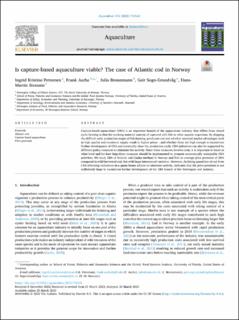Is capture-based aquaculture viable? The case of Atlantic cod in Norway
Pettersen, Ingrid Kristine; Asche, Frank; Bronnmann, Julia; Sogn-Grundvåg, Geir; Straume, Hans-Martin
Peer reviewed, Journal article
Published version
Permanent lenke
https://hdl.handle.net/11250/3063456Utgivelsesdato
2023Metadata
Vis full innførselSamlinger
- Artikler / Articles [1456]
- Publikasjoner fra CRIStin [2533]
Sammendrag
Capture-based aquaculture (CBA) is an important branch of the aquaculture industry that differs from closed cycle farming in that the stocking material consists of captured wild fish or other aquatic organisms. By skipping the difficult early production stages of fish farming, producers can test whether assumed market advantages such as high quality and consistent supply result in higher prices – and whether these are high enough to incentivize further development of CBA and eventually close the production cycle. CBA-initiatives can also be supported by different policy measures to stimulate the activity. Since these measures involve costs, it is important to know at what level and for how long these measures should be implemented to promote economically sustainable CBA activities. We study CBA of Atlantic cod (Gadus morhua) in Norway and find an average price premium of 26% compared to wild harvested cod, but with large interannual variation. However, declining quantities of cod from CBA following reductions in a quota bonus scheme to stimulate activity, indicates that the price premium is not sufficiently large to incentivize further development of the CBA branch of the Norwegian cod industry. Is capture-based aquaculture viable? The case of Atlantic cod in Norway
